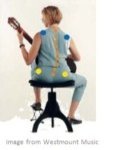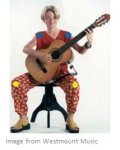Classical guitar sitting positions
Here we're going to talk about how to sit. Now you're probably thinking, 'but I'm sitting right now!'. So true! But sitting correctly for the guitar is a different thing and is very important for your development as a classical guitarist.
I’m getting a lot of messages from people coming here because they want to learn to play guitar as part of worship. If this is you, you might want to join Aaron Anastasi’s programme. Aaron is a musician and a worship leader. He put together a step by step programme for aspiring Christian musicians. If you're interested, you can use the exercises and advice in learn-classical-guitar-today to develop your finger strength and dexterity and Aaron's lessons to work on strumming and worship music.
CLICK HERE TO LEARN WORSHIP GUITAR !!
Let's start with the chair. Use a chair with a firm base that has no elbow rests as these will get in the way of your guitar. While slouching on the couch is great for watch TV, hanging out and tinkering on your guitar, these are not sustainable classical guitar sitting positions as they will definitely lead to bad posture and backache after time. A firm based chair ensures that you won't sink into the middle of an overly soft chair and put pressure on your lower back is excellent for achieving the best classical guitar sitting position. The chair should be high enough so that the shape between your thigh and lower legs forms approximately a 90 degree angle.
While many classical guitar teachers will focus on a set of RULES that prescribe the BEST classical guitar sitting positions, the truth is that there is no such thing. If you watch different performers you will see that sitting positions differ in quite marked ways. There is, however, a set of general principles that apply and best practice as to how best to implement and achieve the aims of these principles. This is where I share these.
Click here for details on guitar supports including the Efel, the Dynarette and the Ergoplay.
Principles for the correct classical guitar sitting position
1. Most important is that the guitarist feels comfortable. Note though that comfort is a relative concept as anybody who has developed a bad habit that they are trying to change will tell you. A good example is smoking or bad posture. While smoking or bad posture might feel comfortable in the short run in the long run there are many negative side effects for the body. When we talk about comfort in the context of classical guitar playing we are talking about a relaxed and straight back, an open chest that allows the musician to breathe freely and deeply and a sitting position that allows for free and easy arm movements. 2.The guitarist's back should be as comfortable as possible with the minimum amount of stress and curvature on it.
2.The guitarist's back should be as comfortable as possible with the minimum amount of stress and curvature on it. 3. The guitarist's leg position should be such that it removes any stress from the lower back. The recommended distance is about shoulder width although some guitarists prefer a wider stance. Different guitar traditions have different traditions with respect to the position of the legs. Many Spanish guitarists, for example, sit with their legs together rather than apart as classical guitarists do. Ultimately, and at this stage, the important thing is to be very comfortable.
 4. The guitarist's left hand should be able to reach the fretboard and get into the correct playing position without having to drop the left shoulder. In classical guitar playing, there are two ways of doing this.
4. The guitarist's left hand should be able to reach the fretboard and get into the correct playing position without having to drop the left shoulder. In classical guitar playing, there are two ways of doing this.
One way is to raise the left leg by using a footstool under your left foot which raises the leg and therefore the guitar resting on it. Raise the footstool to a position that is comfortable for you. People of average height generally find the footstool most comfortable when it is about 6 inches high. This will differ depending on your height and the height of your chair.
 There is some debate about how the footstool should be utilized. Segovia, for example, placed his left foot on the tip of the footstool leaving the rest of his foot free for movement while others have argued that the whole foot should be placed on the footstool. There is also quite some debate about the best angle for the footstool. Pujol argued for a sloping footstool while other musicians have utilized the footstool with very little slope.
There is some debate about how the footstool should be utilized. Segovia, for example, placed his left foot on the tip of the footstool leaving the rest of his foot free for movement while others have argued that the whole foot should be placed on the footstool. There is also quite some debate about the best angle for the footstool. Pujol argued for a sloping footstool while other musicians have utilized the footstool with very little slope.
Another way to raise the guitar is to use a guitar support which rests on the left leg which raises the guitar itself, rather than the leg on which the guitar rests as the footstool does. While the stronger tradition, particularly amongst musicians such as Tarrega and more recently Segovia and Pujol argues for using a footstool, many modern guitarists and teachers argue that the footstool brings with it its own tensions. Most prominent is the argument that raising the left leg results in a twist in the lower spine which results in fatigue for the player and causes stress on the players spine.
These guitarists argue that using a leg support for the guitar releases the tension in the back caused by using a footstool and is a more natural classical guitar sitting position.
Here's a video of the wonderful Per-Olov Kindgren playing Pachelbel's Canon in D. You can see in the video that he is using a guitar support rather than a foot stool
Personally I started using a footstool, but almost rarely use it as I prefer to use a guitar support.
Guitar Basics
You can scroll the rest of the guitar basics pages by scanning the list below, or scrolling through the navigation bar
Buying a Classical Guitar: If you need to buy a guitar or are thinking about buying a new guitar, then this page is for you. It provides useful tips on how to pick your first classical guitar.
Music Theory: Music Theory provides an introduction to musical notation and to the basic theory that you will need to start playing.
Notes on the Guitar: Becoming familiar with the notes on the guitar is essential for any guitarist. This lesson provides guidelines and free guitar software. This is where you pick up the guitar and begin playing.
Finger Names : Finger names in classical guitar scores.
How to Tune your Guitar: How to tune your guitar. There is nothing worse than playing on an untuned guitar. This page teaches you how to tune your guitar with and without an electronic tuner.
Guitar Parts: Start by becoming familiar with the parts of the guitar so that you know what we're talking about when we talk about the bridge or the fret.
Click here for details on guitar supports including the Efel, the Dynarette and the Ergoplay.
Mangore.com provides an excellent article by Renato Belluci on the guitar playing positions. This is an article worth reviewing and reflecting on once or twice a year. It can be found at mangore.com.

You'll need to go a little deeper into music theory as you proceed. The best online resource for this is Guitar Theory Revolution. It recognises that music theory is very hard for guitarists because music theory has till now been located in the piano paradigm. The Guitar Theory Revolution overthrows the piano paradigm that is holding you back and embraces the attributes of the guitar to unpack music theory. In fact, it goes further and allows you to see that the guitar is one of the best instruments for learning theory.





